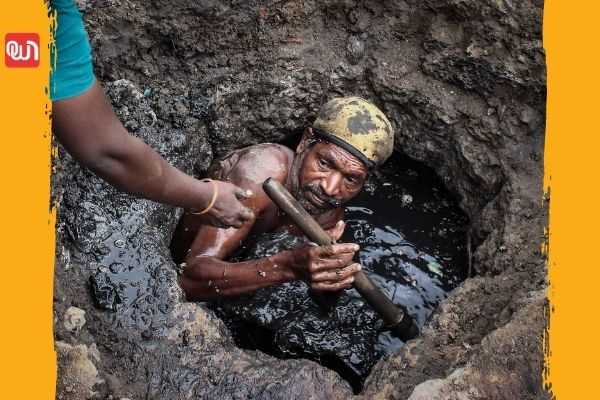
Sanitation Works that are equal to manual scavenging
Manual Scavenging is a term that means ‘manually cleaning, carrying, handling or disposing of human excreta in insanitary latrines, pits, drains or sewers’. The work is regarded as an extremely dehumanizing practice and is illegal in India. But while manual scavenging is illegal, it is scud to see that the definition of manual scavenging overlooks a lot of sanitary works, that are of similar nature to that of Manual Scavenging. In India, close to 5 million people are involved in manual scavenging like work, 2 million of them work in high-risk conditions, yet their work conditions are not counted illegal.
Here is the list of daily labours that should be recognized as manual scavenging
1. Latrine Cleaning
The cleaning of Dry latrines and single pit latrines is very prevalent, especially in rural India. In the country, there are around 7,70,000 latrine cleaners. The job is equivalent to manual treating of human excreta yet, it is not even legally prohibited.
Read more: When a Dalit rape victim knocks on the doors of justice

2. Sewer Cleaning
The country acquires approximately 1 lakh 53 thousand sewer cleaners who do the job of unblocking the sewers, cleaning sewers, and wastewater drains. The work s as dehumanizing as it can be but the definition of manual scavenging doesn’t include it.
3. Faecal Sludge handling
The handling of faecal sludge, transfer, disposal, storage of faecal sludge from pits, latrines, tanks etc, that is often a combination of solid and liquid waste and human excreta is Faecal Sludge handling. It even includes toilet papers, anal washing products and menstrual products in the faecal sludge. It is done by nearly 22,000 workers.
4. Railway Cleaning
Cleaning faecal elements, and human waste from railway tracks and platforms is equally dehumanizing as that of the above and around 95,000 people are employed in the same, of which 80% are women.
5. Community Toilet Cleaning
Well, cleaning someone else’s waste is a simple denial of humanness for that person. In the country, there are as many as 2,02,000 people are involved in the cleaning of public and community toilets and over 8,00,000 cleaners in both, urban and rural are involved in the cleaning and maintenance of school washrooms.
6. Domestic work
Domestic sanitation cleaners, who clean toilets of middle and high-income households and institutions are equal to any of the above. In fact, it is emotionally and mentally daunting too. And, over 2 million people across the country are employed in this work.
Hence, these are the works that are certainly of the same nature as that of Manual Scavenging, but the faults in what is included in the definition of the same don’t include the above mentioned.
Source: Sanitation Workers Project, a study by Dalberg Advisors
Have a news story, an interesting write-up or simply a suggestion? Write to us at info@oneworldnews.com








